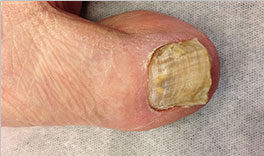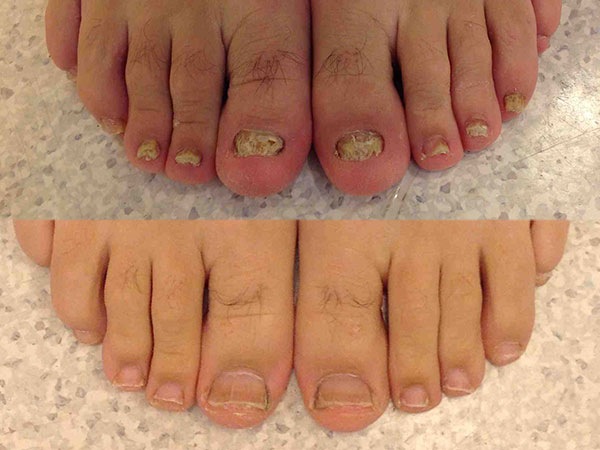Toenail fungus
Conveniently located to serve Omaha, NE
Learn more
BETTER NAILS IN 3-6 MONTHS
Schedule an
appointment
to start your
treatment
Overview
You’ve seen the TV commercial with the creatures having a party inside a toenail. It’s not so funny if you’re the one with the ‘creatures’ in your toenails. Those little creatures are known as dermatophytes (fungus) and they love the keratin that makes up your nails. These critters are actually a fungus and they can cause your nails to become discolored, thick, and misshapen. It’s related to the fungus that causes athlete’s foot, jock itch, and ringworm. While many people choose to live with fungus on their nails, it can be a problem later on in life and can even spread from the nails to the groin or other areas on the body, causing many issues. In severe cases, it can lead to poor circulation in the legs due to infection.

Toenails are more likely than fingernails to be affected by a fungus. This is because feet are exposed to moist, sweaty environments in shoes and socks, which are a breeding ground for fungus.
Dr. Joel Schlessinger and Dr. Daniel Schlessinger, board-certified dermatologists at Schlessinger MD in Omaha, Nebraska can assess your skincare concerns and provide finger or toenail fungus treatment options. They have the medical background to look at all aspects of this condition and work for solutions that will result in improvement. Drs. Joel Schlessinger has been a clinical investigator for many toenail fungus drugs and has helped to develop most of the drugs on the market for toenail fungus, so he knows which ones will work best and which aren’t worth trying.
Q&A with Dr. Schlessinger
Your commonly asked questions answered.
Are you eligible to participate in a clinical trial to test new toenail fungus treatment options?
At the Schlessinger MD Skin Research Center located with Schlessinger MD in Omaha, Nebraska, Drs. Joel and Daniel Schlessinger and their clinical staff conduct research studies to test new medications for skin conditions.
They have conducted clinical research involving medications and treatments for toenail fungus, and clinical studies are ongoing in the clinic on toenail fungus. These innovative treatments are only available in a select group of clinics in the U.S. and available at no cost to study participants.
If you are eligible to participate in a clinical trial of new medications, Dr. Schlessinger can advise you when he sees you during an appointment.
Toenail fungus blogs

Does peroxide kill toenail fungus?
If you’ve noticed your toenails changing in color, texture and thickness, you may be experiencing toenail fungus. It’s often accompanied by other infections, such as athlete’s foot, jock itch in the groin, or, less commonly, infection of the fingernails. Toenail fungus occurs when a microorganism called a dermatophyte finds its way between the toenail and…
Contact us to learn more about our dermatology services.
At Schlessinger MD our skin experts specialize in various treatments because we believe that everyone can have healthy skin. Joel Schlessinger, MD is a highly skilled and experienced board-certified dermatologist, recognized as the Best Dermatologist and Cosmetic Surgeon in Omaha since 2000. Our team is dedicated to providing you with the best results and experience possible. Contact Schlessinger MD today or book your acne appointment online now using our booking tool.
